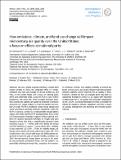How emissions, climate, and land use change will impact mid-century air quality over the United States: a focus on effects at national parks
Author(s)
Val Martin, M.; Lamarque, Jean-Francois; Tilmes, S.; Emmons, L. K.; Schichtel, B. A.; Heald, Colette L.; ... Show more Show less
DownloadMartin-2015-How emissions, clima.pdf (9.492Mb)
PUBLISHER_CC
Publisher with Creative Commons License
Creative Commons Attribution
Terms of use
Metadata
Show full item recordAbstract
We use a global coupled chemistry–climate–land model (CESM) to assess the integrated effect of climate, emissions and land use changes on annual surface O[subscript 3] and PM[subscript 2.5] in the United States with a focus on national parks (NPs) and wilderness areas, using the RCP4.5 and RCP8.5 projections. We show that, when stringent domestic emission controls are applied, air quality is predicted to improve across the US, except surface O[subscript 3] over the western and central US under RCP8.5 conditions, where rising background ozone counteracts domestic emission reductions. Under the RCP4.5 scenario, surface O[subscript 3] is substantially reduced (about 5 ppb), with daily maximum 8 h averages below the primary US Environmental Protection Agency (EPA) National Ambient Air Quality Standards (NAAQS) of 75 ppb (and even 65 ppb) in all the NPs. PM[subscript 2.5] is significantly reduced in both scenarios (4 μg m[superscript −3]; ~50%), with levels below the annual US EPA NAAQS of 12 μg m[superscript −3] across all the NPs; visibility is also improved (10–15 dv; >75 km in visibility range), although some western US parks with Class I status (40–74 % of total sites in the US) are still above the 2050 planned target level to reach the goal of natural visibility conditions by 2064. We estimate that climate-driven increases in fire activity may dominate summertime PM2.5 over the western US, potentially offsetting the large PM2.5 reductions from domestic emission controls, and keeping visibility at present-day levels in many parks. Our study indicates that anthropogenic emission patterns will be important for air quality in 2050. However, climate and land use changes alone may lead to a substantial increase in surface O[subscript 3] (2–3 ppb) with important consequences for O[subscript 3] air quality and ecosystem degradation at the US NPs. Our study illustrates the need to consider the effects of changes in climate, vegetation, and fires in future air quality management and planning and emission policy making.
Date issued
2015-03Department
Massachusetts Institute of Technology. Department of Civil and Environmental EngineeringJournal
Atmospheric Chemistry and Physics
Publisher
Copernicus GmbH
Citation
Val Martin, M., C. L. Heald, J.-F. Lamarque, S. Tilmes, L. K. Emmons, and B. A. Schichtel. “How Emissions, Climate, and Land Use Change Will Impact Mid-Century Air Quality over the United States: a Focus on Effects at National Parks.” Atmospheric Chemistry and Physics 15, no. 5 (2015): 2805–2823.
Version: Final published version
ISSN
1680-7324
1680-7316